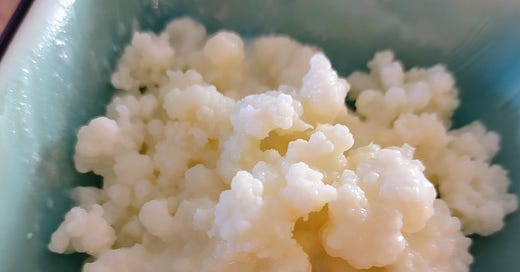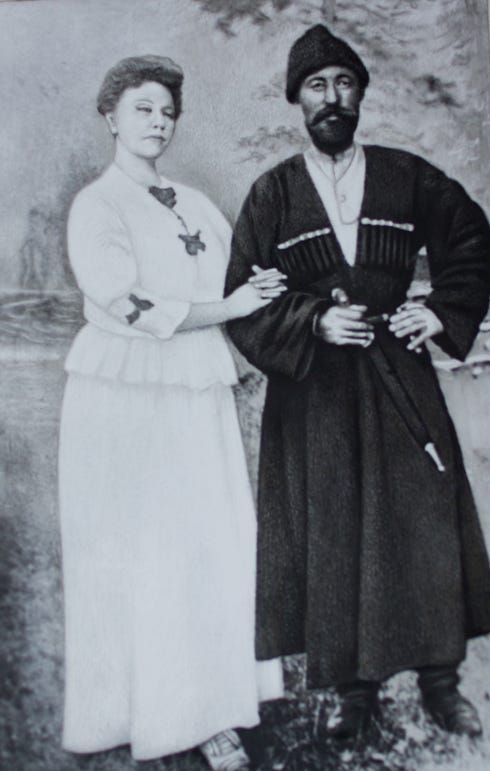The Wild and Amazing Reason 10 lbs of Kefir Grains Became a Coveted Trophy
The story of a beautiful Russian spy, a wealthy prince, a kidnapping and a ransom.
The History, Mystery, and (Mis?)Adventures of Kefir Grains
The story of how kefir grains became a worldwide food, is wrapped in mystique, seduction, and Russian espionage. The fascinating story has more twists than a James Bond movie.
But first, a technical clarification. Kefir “grains” are not actually grains. They are small, gelatinous clumps of bacteria and yeasts that look like cooked rice. When added to milk, these microorganisms digest the proteins and sugars in the milk, leaving behind billions of probiotics and enzymes, and giving us partially digested milk.
The word "kefir" is derived from the Turkish word "keyif," which means "good feeling" or "pleasure."1
The first origins of kefir appear to be lost to time, although we can piece together bits of the story. Consumed for centuries in Eastern Europe and parts of Asia, kefir is well known in these regions as a food for health and longevity. According to legends in the Caucasus mountains, the Prophet Muhammad gave kefir grains–nicknamed “seeds of the prophet”--as a gift to the Karachai people.2
The stories say that shepherds would store fresh milk and these “seeds” in leather bags made from animal hides. The milk would ferment and create a sour, effervescent beverage–kefir. As the shepherds drank the fully fermented kefir, they would add more milk to the bag, thus consistently feeding the kefir grains and creating a continual source of new kefir. This became a staple for the Karachai diets.
Shrouded in superstition, the people of this region carefully guarded their secret for centuries. They bestowed almost mystical powers on these humble grains thinking that “the grains would lose their “magical” powers if their existence were revealed to outsiders. To talk about it, or worse, to give it away, was to commit a religious crime and to risk destroying an ancient tradition.”3
Neighboring countries noticed the health and longevity of the Karachai people. They believed that was, in part, from the kefir. But they could not replicate it nor could they get their hands on the kefir grains for themselves.
Bringing kefir to the rest of Europe took courage, integrity, espionage, and seduction. This responsibility was placed on the shoulders of a passionate young woman–Irina Sakharova.
Espionage, Seduction and Abduction
If you enjoy kefir today, you can thank Irina Sakharova. Her integrity and courage brought kefir out of the mountains and allowed it to spread.
When faced with a choice to accept unimaginable wealth instead of kefir grains, 20- year old Irina turned down jewels and riches to maintain the integrity of her mission: to bring kefir grains to Russian doctors.
Would you do the same?
After centuries of Russians' fascination with the longevity of the Caucasian mountain people, “some doctors attributed this vitality to kefir, and they obtained it to test on patients. The earliest scientific studies of the time declared that kefir helped treat many illnesses such as digestive disorders and tuberculosis.”4
But, without the “grains,” these doctors and scientists could not accurately reproduce kefir.
In the early 1900s, “determined to obtain the elusive kefir grains in order to make kefir for their patients on an industrial scale, members of the “All Russian Physician’s Society” approached two brothers named Blandov with a request for them to procure kefir grains for the project. The Blandov brothers owned and ran the large Moscow Dairy and also owned cheese-manufacturing factories in the town of Kislovodsk in the Northern Caucasus region.”5
One of the brothers, Nikolai, sent his young employee, Irina, on a mission: seduce the Karachai Prince, Bek-Mirza Barchorov “so he would offer her kefir grains and the secret to ferment kefir.”6
According to the stories, “the prince was indeed seduced. During her stay, Sakharova received flowers and gifts of all kinds, and the prince never took his eyes off her during the celebrations. The young woman took advantage of this attention and insisted that he offer her some precious kefir grains.”
Remember the superstition about sharing kefir grains with foreigners?
Prince Bek-Mirza Barchorov “refused to reveal his secret. Sakharova returned home empty-handed.”7
As she traveled home, the prince kidnapped her. He wanted to marry her.
“Following her kidnapping, Irina remained steadfastly silent while the prince proposed marriage to her, buying herself enough time for her employers — the brothers Blandov — to organize a daring mission to save her from a forced marriage to the besotted prince.”8
When the Czar, Nicolas II learned of the escapades, he required that the Prince offer compensation for his actions or risk “disturbing relations between the two peoples.
[The prince] offered jewelry, gold and treasures, but Sakharova refused. She had a mission to fulfill, and did not intend to fail. Under the order of the Czar, and at the sustained demands of Sakharova, the prince had to hand over the kefir grains to her. In 1908, Irina Sakharova brought the first grains of milk kefir to Russia.”9
It is because of Irina’s integrity that we have kefir today. Can you imagine what those negotiations must have been like? What must she have said for that deal to go through?
Kefir quickly spread through Europe. Doctors used this fermented dairy product to treat multiple ailments to great success.
To Make, or To Buy?
Kefir is a popular drink today, cited for its many anecdotal health benefits.
While kefir is now readily available in stores across the US, there are distinct differences between what you can buy and what you can make at home. Store bought brands offer a range of kefir products, including plain and flavored varieties (often with lots of sugar added). Small amounts of kefir grains are available online or from people making their own kefir.
The biggest difference between store bought kefir and making it at home is that homemade kefir is often raw. When you use raw milk to make kefir in your own home, you get the closest match to the traditional kefir of the Caucasus Mountain people.
Due to regulatory constraints, most commercial sales of kefir made from raw milk are prohibited.
To get the most out of kefir, start with local, grassfed raw milk and make your own kefir by adding the grains and fermenting at 75 degrees (or room temp) for about 24 hours or until desired fermentation is reached.
As you make kefir, the population of grains will increase and the kefir will become stronger more quickly. Divide the grains, and keep going. Make sure to feed the grains with fresh milk each day. Give away the abundance.
Next time you enjoy a taste of kefir, remember the daring exploits of Irina Sakharova that brought this amazing beverage to us.
Can you imagine what Irina endured to bring us kefir grains? Would you do the same?
https://www.beaumont.org/health-wellness/blogs/what-the-heck-is-kefir
https://revolutionfermentation.com/en/blogs/milk-kefir/the-fascinating-origins-of-kefir-grains/
https://revolutionfermentation.com/en/blogs/milk-kefir/the-fascinating-origins-of-kefir-grains/
https://qualitykefir.com/history-of-kefir/
https://russianlife.com/the-russia-file/magical-kefir/
https://qualitykefir.com/history-of-kefir/
https://qualitykefir.com/history-of-kefir/
https://russianlife.com/the-russia-file/magical-kefir/
https://qualitykefir.com/history-of-kefir/







I am so invested in this! Kefir indeed has a rich history.
Irina is a representation of a strong woman! Perfect for the celebration of Women's month.